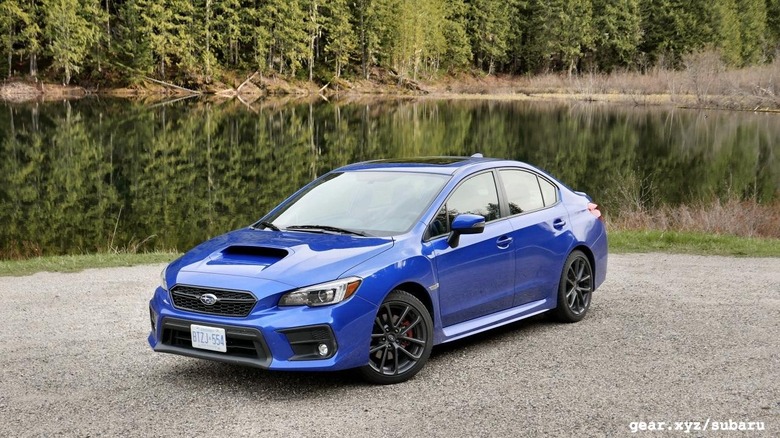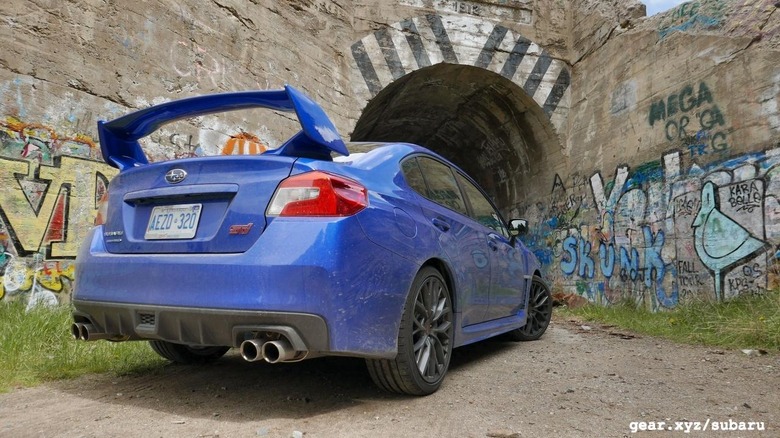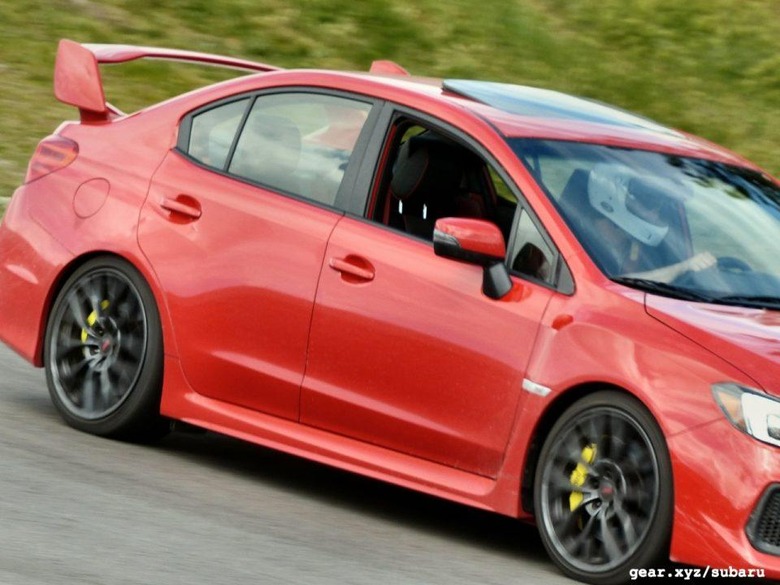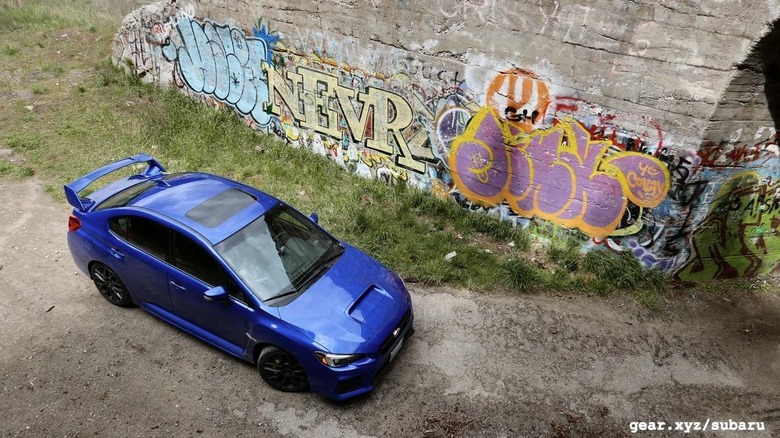2018 Subaru WRX and WRX STI First Drive: One-two turbocharged punch for street and track
You don't have much time to acknowledge the bear sitting upright on the side of the highway when you're behind the wheel of the 2018 Subaru WRX. There's something about being hammer-down on the zigzag roads that wrap around the river leading into the town of Kaslo, British Columbia – almost like someone had stretched out an enormous tangled slinky and then abandoned it in frustration – that does wonders to focus the mind on the task at hand. At these speeds, you do you, and the bear does whatever it is 600 lbs of black-furred muscle does when it encounters 3,300 lbs of screaming bright blue metal that vanishes around the next bend in a burst of gravel and off-throttle turbo-whump.
In the moment, it's hard to imagine a better tool four-seasons tool for backwoods blasts down seemingly forgotten mountain highways than the WRX, until you realize that you're still a few rungs below the mightier, and more rambunctious WRX STI sedan. Fortunately for me, Subaru has brought both along on this adventure, and I'll spend the next two days swapping back and forth between the two compact performance cars and avoiding predatory wildlife in the process.

Subaru has made a series of 'squint or you'll miss them' changes to the styling of both cars for the 2018 model year that are certainly invisible to the ursine eye but undoubtedly apparent to the breed of enthusiasts who have claimed the Japanese brand as their battle flag. Grilles, front bumpers, and door trim on both cars are what will immediately stand out to fans of the WRX and STI, with the latter car also offering the option to go wingless (in favor of a modest trunk lip spoiler) and losing fog lights on some models in favor of brake cooling ducts for its now-embiggened – and bright yellow – six-piston Brembo front calipers. Similarly subtle updates can be found throughout the interior of each car, with highlights including a more useful multi-function LCD display perched on the dash as well as a fold-down armrest for rear passengers. Underneath the cosmetic updates, however, you'll find the same basic platform underpinning both the WRX and the STI as you have for the past several years.
Tempting local law enforcement in the Subaru WRX and WRX STI for a full two days of hooning through the interior of Canada's westernmost province revealed several more interesting aspects of the updated mechanical package afforded to both cars. For starters, the humbler WRX has seen its transmission gifted with smoother (once warm) triple-cone synchros, has had its electric power steering retuned and reduced (in terms of packaging), and now features a rear sway bar diameter that's been shaved by a millimeter in order to work with the shock and spring reconfig found at all four corners. There's also the new Performance Package on the Premium trim level, which grants access to more aggressive, track-oriented Jurid brake pads as well as grippy Recaro sport seats.
Driven back-to-back with the WRX STI, the WRX with the Performance Package proved itself a very capable machine, especially when set loose on a 25 mile stretch of narrow dirt and gravel road that offered ample opportunities for handbrake hairpin shenanigans. Shake the dust off of its 18-inch alloy boots, however, and the sedan deigns not to punish you once back on the pavement, maintaining a smooth cruising personality that can be discarded at the drop of a gear.

How the WRX STI justifies its higher purchase price ($36,955 versus $27,855 for the WRX) and more extroverted styling is easily understood once it's time to get serious about putting distance between you and whichever of nature's highly-effective four-legged killers is in pursuit. In the wilds of B.C.'s Okanagan Valley, the STI's hydraulically-assisted steering was chatty to the point of gossip about the details of the pavement I was passing over, while the stiffer and ultimately more direct suspension setup was willing to flip the standard WRX's lean towards comfort versus engagement.
In fact, unlike many good / better / best flavors of in-house performance partners, the WRX and the WRX STI truly offer different packages that reveal themselves to have significantly different personalities – something that a quick visit to Area 27, Canada's most recent road course amply illustrated. Confirming what the mountain roads had already strongly suggested, the track's three miles of challenging asphalt, (designed by the country's last Formula One champion, Jacques Villeneuve) revealed the STI to be the cold-blooded killer as compared to the base WRX's more accessible limits.

While both cars are gifted with standard all-wheel drive, the STI's Driver Controlled Center Differential (DCCD, also updated for 2018) provides a level of granular control over power distribution that's simply absent from it sibling (and stands as the only real piece of digital trickery in what remains a largely mechanical approach to managing traction). It's a similar story when it comes to the six-speed manual transmission found in each sedan: the number of gears may be the same, but their design, and they way they allow the driver to access the power band, are both quite different. These two details were far more apparent on the track than on the street, adding light and shade to the STI's more dialed-in package.
You may have noticed that I've yet to mention the power differential between the two cars. That's because in my mind, it's not the most salient point of divergence when determining which model is best for a driver's particular needs. There's no question that the older turbocharged 2.5-liter four-cylinder found under the hood of the WRX STI's 305 horses and 290 lb-ft of torque handily top the WRX's 2.0-liter turbo four's 268 ponies and 258 lb-ft of twist, but if straight-line speed is what you are after then a trip to the aftermarket will sop up as much money as you're willing to throw at your dyno run bragging rights.

For the majority of drivers, of course, the 'regular' Subaru WRX will be more than enough to keep a smile firmly in place once the car escapes the grind of the daily commute and busts loose on a traffic-free two-lane, cone-littered autocross course, or local lapping day. For those who want to get more serious about a dual-purpose track toy, the WRX STI pulls ahead with the kind of focused intensity not often seen outside of an Ivy League cram week. The fact that Subaru is able to not just one, but both of these reasonably affordable, high performance options in a world where most turbocharged pocket rockets insulate the experience behind the wheel more ones and zeros than you'll find in Warren Buffet's bank account is nothing short of astonishing for such a small company.
